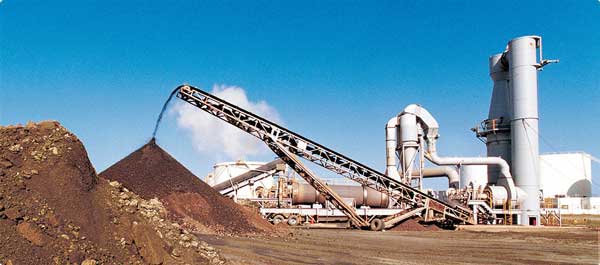With the continuous development and progress of the society, people’s use of resources has been continuously improved, and even excessive exploitation of resources has led to continuous changes in the environment, showing a terrible situation of linear decline. Let’s take a look at the relevant information on soil remediation.
Soil remediation definition
Soil remediation refers to the physical, chemical and biological methods of transferring, absorbing, degrading and transforming contaminants in the soil to reduce their concentrations to acceptable levels or to convert toxic and harmful contaminants into harmless substances. Fundamentally, the principles of contaminated soil remediation processes can include:
(1) changing the existing form of pollutants in the soil or the way of combining with the soil, reducing its mobility and bioavailability in the environment;
(2) Reduce the concentration of harmful substances in the soil. China’s soil pollution has threatened the sustainable use of land resources and the ecological security of agricultural products. The country’s farmland contaminated by organic pollutants has reached 36 million hectares. The types of pollutants include petroleum, polycyclic aromatic hydrocarbons, pesticides, organic chlorine, etc.; the area of serious oil contaminated land caused by oilfield exploitation is 10,000 hectares, and the petroleum refining industry It also pollutes large areas of land.
In the petroleum sewage irrigation area, the content of polycyclic aromatic hydrocarbons in the surface layer and the bottom layer exceeds 600 mg/kg, causing serious pollution of crops and groundwater. The country’s heavy metal contaminated land reached 20 million hectares, of which more than 700,000 hectares of heavily polluted land, of which 130,000 hectares were forced to abandon arable due to excessive cadmium content. Because of this, the research on contaminated soil remediation is undergoing a transition from laboratory research to a practical stage, and is about to enter a period of rapid and comprehensive governance.
Soil remediation process
Thermodynamic repair technology: the use of heat conduction, thermal blankets, hot wells or hot walls, or thermal radiation, radio wave heating, etc. to achieve the repair of contaminated soil.
Thermal desorption repair technology: heating the soil contaminated by organic matter to the boiling point of organic matter above the organic matter in the adsorbed soil volatilized into a gaseous state and then separated. Thermal desorption technology is one of the most advanced pollution treatment technologies in the world. The main treatment targets are pesticide-contaminated soil, oil-field oily waste, and tank bottom sludge. The operation principle is to utilize the thermal instability of the organic matter in the polluted waste, realize the separation of the pollutant and the soil through the indirect heating method of non-incineration, and can completely separate the solid phase, the oil phase, the water phase and the gas phase in the waste. Most of the recycling is fundamentally harmless, so the technology is widely used in oil field waste disposal operations around the world.
Incineration method: Incinerate contaminated soil in an incinerator to make high molecular weight harmful substances? Volatile and semi-volatile, decomposed into low molecular smoke. After dedusting, cooling and purification, the flue gas reaches the discharge standard.
Landfill method: use waste as a mud to apply sludge to the soil. Adjust soil nutrient, humidity and pH by fertilizing, irrigating, adding lime, etc. Maintain aerobic degradation of pollutants in the upper layer of soil. For soil pH and humidity can be measured with a soil acidity meter, soil EC values can be measured with a soil EC meter to see the soil improvement effect.
Chemical leaching: The chemical/biochemical solvent that promotes the dissolution or migration of pollutants in the soil environment is used to push the eluent into the contaminated soil layer under gravity or by head pressure, and then contain the pollutants. The solution is extracted from the soil for separation and wastewater treatment techniques.
Composting method: using traditional composting method, accumulating contaminated soil, mixing pollutants with organic matter, straw, wheat straw, wood chips and bark, etc., relying on the action of microorganisms in the composting process to degrade the soil. Organic pollutants.
Phytoremediation: The use of agricultural techniques to improve the chemical and physical constraints that are unfavorable for plant growth, making it suitable for planting, and directly or indirectly absorbing, volatilizing, separating, and degrading by planting preferred plants and their rhizosphere microorganisms. Contaminants, restore and rebuild natural ecological environment and vegetation landscape.
Infiltration reaction wall: It is an in-situ treatment technology. In the shallow soil and groundwater, a wall with permeability and reactive materials is constructed. When the polluted water passes through the wall, the pollutants and the reaction materials in the wall occur. Physical and chemical reactions are removed and removed.
Bioremediation: A controlled or spontaneous process that uses organisms, especially microbes, to catalyze the degradation of organic contaminants to repair contaminated environments or eliminate contaminants in the environment. Among them, microbial remediation technology utilizes microorganisms, indigenous bacteria, foreign bacteria and genetic engineering bacteria to convert and degrade pollutants by metabolizing pollutants, and is mainly used for degradation of organic pollutants in soil. By changing various environmental conditions such as nutrition, redox potential, and co-metabolism matrix, microbial degradation is enhanced to achieve the purpose of treatment.



